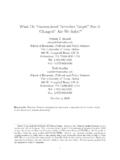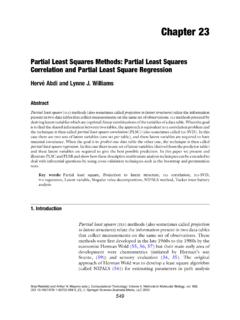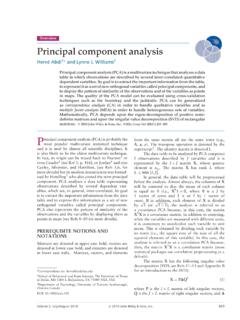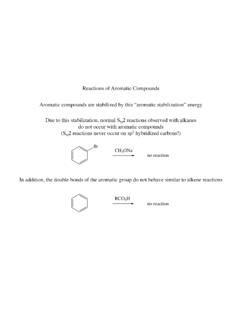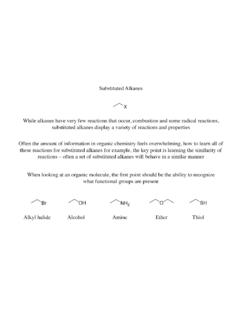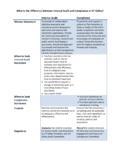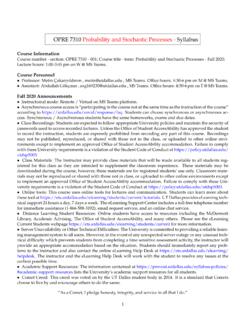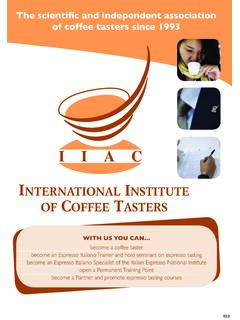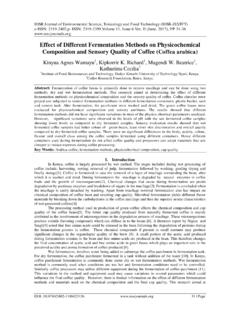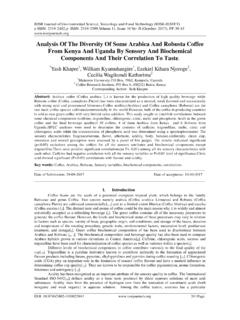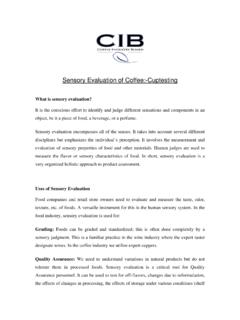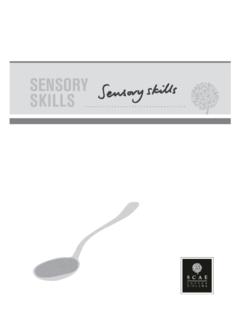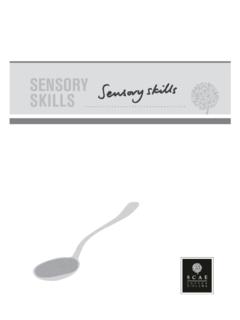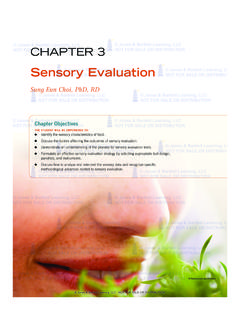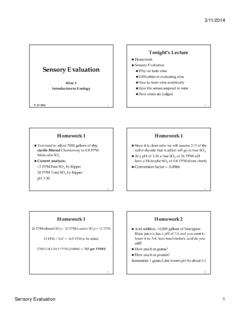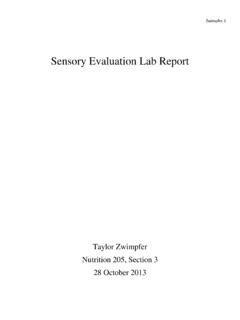Transcription of ;A Ð Ï - The University of Texas at Dallas
1 Dominique ValentinSylvie CholletSebastien L Dzung Hoang NguyenHerv AbdiEditors FROM SENSES TO QUALITY: WHAT CAN sensory evaluation BRING TO QUALITY CONTROL Proceedings of the SPISE 2014 meeting Ho Chi Minh City, Vietnam, July 25 27, 2014. Edited by Dominique Valentin, Sylvie Chollet, S bastien L , Dzung Hoang Nguyen, & Herv Abdi SPISE 2014: FROM SENSES TO QUALITY WHAT CAN sensory evaluation BRING TO QUALITY CONTROL Nhi u t c gi NH XU T B N I H C QU C GIA TH NH PH H CH MINH Khu ph 6, Ph ng Linh Trung, Qu n Th c, TP H Ch Minh S 3, C ng tr ng Qu c t , Qu n 3, TP H Ch Minh T: 38239171 - 38225227 - 38239172 Fax: 38239172 E-mail: PH NG PH T H NH S 3, C ng tr ng Qu c t , Qu n 3, TP H Ch Minh T: 38239170 - 0982920509 - 0913943466 Fax: 38239172 - Website: Ch u tr ch nhi m xu t b n: NGUY N HO NG D NG Ch u tr ch nhi m n i dung: NGUY N HO NG D NG T ch c b n th o v ch u tr ch nhi m v t c quy n TR NG I H C B CH KHOA HQG TPHCM Bi n t p.
2 PH M ANH T NGUY N HU NH S a b n in: NGUY N TI N NAM Tr nh b y b a: TR NG NG C TU N Nh xu t b n HQG-HCM v t c gi / i t c li n k t gi b n quy n Copyright by VNU-HCM Publishing House and author/co-partnership All rights reserved S l ng 200 cu n, Kh 19 x 27 cm, KKHXB s 471-2014/CXB/05-37 Quy t nh XB s 148, ng y 24/7/2014. c a NXB HQG-HCM. In t i: X ng in Tr ng i h c B ch khoa TP HCM /c: 268 L Th ng Ki t, Ph ng 14, Qu n 10, TP HCM N p l u chi u th ng 8 n m 2014. ISBN: 978-604-73-2450-7 FOREWORD Spise2014: From senses to quality: What can sensory evaluation bring to quality control, the fourth symposium on sensory evaluation in Asia, was held on July 25 27, 2014 at Ho Chi Minh-city University of Technology, Vietnam.
3 We had the great pleasure to welcome about one hundred scientists from Vietnam, Japan, South Korea, Singapore, Thailand, Indonesia, the USA, and France. The focus of this year was on quality control. Quality control (QC) ensures that a manufactured product or performed service adheres to a defined set of quality criteria or meets the requirements of the client or customer. For many years, QC in food companies relied mostly on chemical and microbiological analyses. Organoleptic testing was performed by the company expert who, through years of accumulated experience, was able to describe company products and set standards of quality by which raw materials should be purchased and product manufactured and marketed. More recently, the need of providing a more standardized environment for product evaluations has became apparent and a variety of scorecards were developed to serve as a basis for maintaining records and implementing a more rigorous process.
4 These scorecards became the standards to assign quality grades to the products as, for example, in the olive oil or coffee industries, and the individual expert is now replaced by a small group of trained experts whose task is to make a consensual decision. Nowadays, more and more food companies start to integrate sensory evaluation in their QC programs and scoring ring procedures are replaced by discriminating, descriptive, and consumer acceptance procedures. sensory quality can be viewed from two different perspectives: the product and the consumer perspectives. The chapters in this proceeding represent these two perspectives. Product oriented chapters present some new methodological developments in sensory evaluation for quality control such as the tetrad method for difference tests as well as some applications of classical methods such as shelf-life modeling, grade classification, or sensory quality index.
5 Consumer oriented chapters focus on different aspects of food quality such as product nutritional or environmental quality as well as individual factors affecting product perceived quality such as culture or physiological states. All chapters are organized into three topics which we have used to organized this meeting sessions and themes: 1. sensory evaluation in Quality Control 2. sensory evaluation in product development 3. Fundamentals of sensory perception. We would like to use this opportunity to express our gratitude to our two keynote speakers, Prof. Kwang-Ok Kim and Dr. Ho Huy Tuu for their great contributions. Our special thanks are due to our partners who participated in the organization of this meeting: the HCMC University of Technology, AgroSup Dijon, CSGA, AgroCampus-Ouest, and Groupe ISA Lille.
6 We would like to thank our sponsors for their generous help: Fizz-Biosystems, Logicstream, Flavoractiv, and Bel Vietnam. We extend our special thanks to those who have helped us so much and worked so hard to make this event possible: Le Minh Tam, Phan Thuy Xuan Uyen, Nguyen Ba Thanh, Nguyen Thi Thu Ha, Nguyen Quoc Dung, Nguyen Quoc Cuong, Le Thuy Linh, Vu Thi Thanh Phuong, Ung Pham Tuong Thuy, Nguyen Quang Phong, Tran Thi Hong Cam, Vu Kien Thong, Phan Lai Minh Tam, Quach Tan Phat, Tang Nguyen Minh, Nguyen Quang Hung, and Do Mai Uyen Phuong. Dominique Valentin Sylvie Chollet S bastien L Dzung Hoang Nguyen Herv Abdi TABLE OF CONTENTS PART 1 - sensory evaluation IN QUALITY CONTROL _____ 1 The effects of the perceptions of food (fish) quality and risks on vietnamese consumer satisfaction and consumption _____ 1 Accelerated vs.
7 Real time modeling for shelf life: an example with fortified blended foods ____ 16 Application of quality index method for freshness of chilled stored farmed Cobia (Rachycentron canadum) portion _____ 21 Sustainability labels: A key component of food quality? Impact of food-processing information on the appreciation of bread. _____ 27 Effect of sensory attribute on drinking yogurt in viewing of Thai consumer _____ 38 sensory evaluation as a tool in assessing the quality of new fermented products _____ 42 sensory quality indices and consumer acceptability of functional soft drink from Thai berries (Antidesma thwaitesanum Muell Arq.) during storage conditions _____ 49 Role of sensory evaluation in quality control: A textual point of view _____ 56 PART 2 - sensory evaluation IN PRODUCT DEVELOPMENT _____ 61 Potential use of pumpkin flour instead of wheat starch in a noodle product _____ 63 Preference mapping from the combination of customer linking and quantitative descriptive analysis on sensory quality of soymilk products _____ 66 Cross-cultural differences in consumer quality perception of rice _____ 71 PART 3 - FUNDAMENTALS OF sensory PERCEPTION _____ 79 Power comparsion of triangle and tetrad tests applied to high ethanol beverages _____ 81 Effect of freezing pomegranate juice to sorbet on flavor _____ 88 Consumer acceptibility of partial substitution of wheat flour with the glutinous puffed rice, khao ma.
8 Flour on muffin _____ 94 Comparison of consumer preferences of dog food products between Thailand and Singapore using choice based conjoint analysis _____ 99 Effects of miracle fruit juice on the changes in basic tastes recognition threshold and the sensory quality of orange juice _____107 sensory Aroma and Related Volatile Flavor Compound Profiles of Different Black Tea Grades (Camellia sinensis) Produced in Northern Vietnam _____113 PART 1 - sensory evaluation IN QUALITY CONTROL SUMMER PROGRAM IN sensory evaluation From Senses To Quality What can sensory evaluation bring to quality control? 2014 4th International Symposium, July 25-27, VietNam Ho, H. T. and Le, N. H., SPISE Proceedings 4 (2014), 1-15 THE EFFECTS OF THE PERCEPTIONS OF FOOD (FISH) QUALITY AND RISKS ON VIETNAMESE CONSUMER SATISFACTION AND CONSUMPTION Ho, H.
9 T. a and Le, N. H. b a Nha Trang University , Kh nh H a, Vietnam b Ho Chi Minh City University of Technology, HCMC, Vietnam ABSTRACT Purposes This paper presents the idea that food quality management and control should be based on marketing orientation perspectives. It aims to explore the cues, reasons, criteria and sources of perceived quality and food risks, then investigates their influences on consumer satisfaction and consumption toward food (fish) in Vietnam. Finally, it recommends some directions for future research in both food marketing and Quality Control. Methods This presentation is based on a range of research studies using different data sets collected across provinces in Vietnam, and using different methods to analyze the data and test constructs, hypotheses and models.
10 Findings First, it indicates that nutrition and taste occupy the highest ratio explaining for positive attitudes (perceived quality), while safety and negative feelings are dominated to explain negative attitudes (food risks). Consumers with more positive (negative) reasons have a higher (lower) consumption. Second, perceived quality as a multidimentionl construct is found to have a positive effect on consumer satisfaction, while negative feelings have a negative effect on satisfaction. Perceived price has no a significant influence on satisfaction but a significant positive effect on perceived quality. The results also show that there are four groups of reasons causing food risks coming from producers, sellers, consumers and products.
